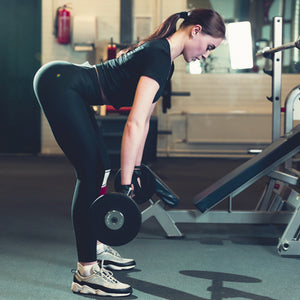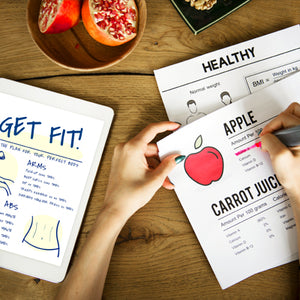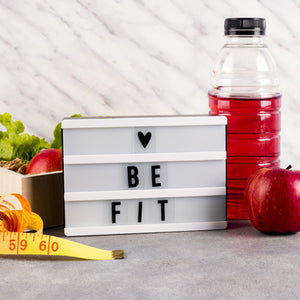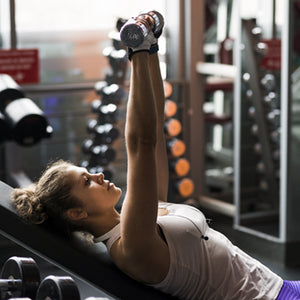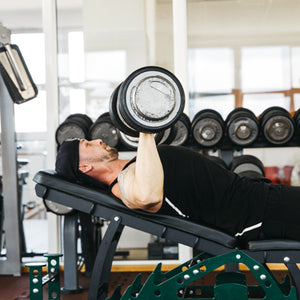
Answered: The Top Gym Questions About Diet, Fitness, and Exercise
Top Gym Question #1: What are the Best Workouts for Building Muscle?
When people want to build muscle, they often hone in on specific isolated movements that target the muscles they want to strengthen and grow. And while that may make sense on paper, you'll get far more out of your workout if you instead target compound movements. In one recent study, compound movements were significantly "more efficient for improving muscle strength and maximal oxygen consumption."
What Are Compound Lifts?
Compound lifts are movements that hit multiple muscle groups at once. For instance, an isolated workout includes exercises like seated calf raises or prone leg curls. In contrast, a compound workout might include squats (which hit numerous muscles, including your calves, quadriceps, and glutes).
What are the Benefits of Compound Lifts?
When you hit multiple muscle groups at once, you'll:
- Burn more calories, helping you to better lose excess weight or maintain a healthy, lean weight
- Boost the coordination between different muscles, tendons, and joints, which enhances your overall athleticism and exercise performance
- Improve both your muscle strength, muscle size, and flexibility
- Elevate your heart rate and oxygen consumption (a trusted measure of fitness exertion)
If you're new to compound workouts, add these six compound exercises to your workout routine today!
Top Gym Question #2: What are the Best Workouts for Burning Fat?
If you've ever taken part in a heart rate-focused workout routine, you've likely read that a lower heart rate (namely, heart rate zone 2 where your maximum heart rate is only at 60% to 70%) is where your body burns the most calories. This concept is backed by numerous studies.
In truth, your body burns fat and calories at all heart rate levels. And while maintaining a lower heart rate (i.e., reducing your workout intensity) may be effective, the American Council on Exercise (ACE) reports that you'll actually burn more calories and fat as you push yourself harder.
The verdict? Pay less attention to your heart rate zone and instead focus on gradually increasing your workout intensity. For the best workouts for burning fat, including stubborn belly fat, ACE recommends:
- Workouts focused on compound lifts (compound lifts are the best workouts for increasing muscle mass, and muscle tissue burns more calories per minute than fatty tissues, thus increasing your metabolism over time)
- Mixing up your workout routine so that you're lifting very heavy on some days, while other days focus on lifting lighter but incorporating more reps into that day's schedule
- Incorporating strength-building cardio, such as high-intensity interval training
Unfamiliar with high-intensity interval training? Try these eight killer HIIT workouts that you can do in under 15 minutes!
Top Gym Question #3: How Do You Know if You're Exercising Hard Enough?
Workout intensity is key for breaking through fitness plateaus and achieving your fat loss, weight loss, or muscle-building goals. Yet we often trick ourselves into thinking we're working out harder than we really are.
Check in with yourself when you're at the gym to ensure you're achieving the right workout intensity:
- Use the talk test: A good workout should leave you a little out of breath and struggling to talk, yet still able to speak. However, if you're able to chat away with a gym friend for a few minutes, you probably should be pushing yourself harder.
- Use the rep test: When lifting weights, you should always struggle to complete the last one or two reps in your set. If you're able to squeeze out three, four, or more reps, you probably want to increase the amount of weight you're using.
Careful: Overtraining can sabotage your fitness results just as much as under-training. Push yourself as hard as you can, but pull back a bit if you're experiencing these eight common signs of overtraining.
Top Gym Question #4: Is it Better to Use Machines Versus Free Weights?
The International Sports Sciences Association notes that, as with any approach to fitness, there's not always a clear winner when comparing weight machines (e.g., chest press machines, lat pull-down machines, etc.) with free weight workouts (e.g., barbell bench presses, dumbbell lat pull-downs, etc.).
On the one hand, weight machines are often better at overloading a muscle group or targeting an isolated muscle group (e.g., a bicep curl machine keeps your arm stationary, so you aren't overcompensating using your shoulder strength). They also force you to follow the proper range of motion, reducing your risks of injuries.
On the flip side, free weights are better for so-called "functional fitness" because they better follow your actual bodily movements. The instability created by using free weights also makes them better for recruiting the small helper muscles around your main muscles and joints and may be more effective at boosting muscle power and stability.
Put simply, use both free weights and weight machines for a well-rounded workout. And if you're new to the gym, focus on machines to help you get used to these movements without injuring yourself.
Top Gym Question #5: What Should I Eat on Workout Days?
People often think of diet and exercise as two separate components of their fitness journey, but the two go hand in hand. You can't outrun a poor diet (pun intended). Likewise, eating the right fuel on your gym days will provide your body with everything it needs for a great workout and enhanced post-workout recovery.
Elite athletes (i.e., Olympians, professional bodybuilders, etc.) dial in their meal timing down to the minute, but don't overthink it. Instead, focus on these expert-approved general meal timing principles:
- Eat a 1,000-calorie pre-workout meal 2-4 hours before you hit the gym
- Aim to eat 2 grams of carbohydrates for every kilogram of body weight
- Reduce your pre-workout meal to 300-400 calories if you're eating an hour before your workout, suggests the National Academy of Sports Medicine, and dial back the carbohydrates to 1 gram per kilogram of body weight
- Focus on easy-to-digest healthy carbohydrates, such as whole-grain bread or oatmeal
- Stay hydrated by drinking 32-ounces of fluids before your workout
- Sip 12 ounces of fluids every 30 minutes during your workout, which NASM reports has been shown to improve muscle endurance
- Eat a recovery meal after your exercise, ideally within the first half-hour after you've finished your workout routine
- Focus on consuming 1 to 1.5 grams of carbohydrates per kilogram of body weight
- Include a high-protein ingredient, such as a protein shake, and aim for at least 25 grams of protein in that post-workout meal or shake
Put on your chef's hat and follow our 3-step guide to an effective muscle-building diet.
Finally, some of the top gym questions on Google include people asking, "What's the best protein shake?" and "What are the best supplements for building muscle?" Tiger Fitness' collection of workout supplements, including best-selling post-workout supplements like amino acid powders and popular protein powders, makes it easy to refuel before, during, and after your workout. No matter your top fitness questions, browse our supplement stacks today and take the guesswork out of your gym nutrition.

